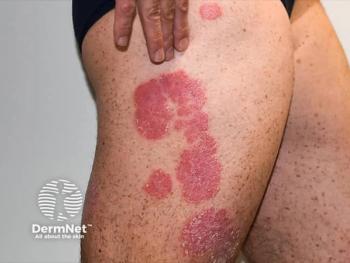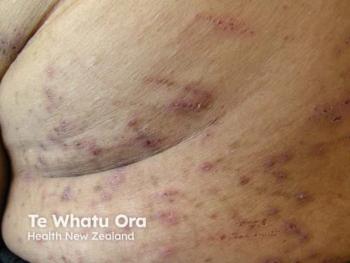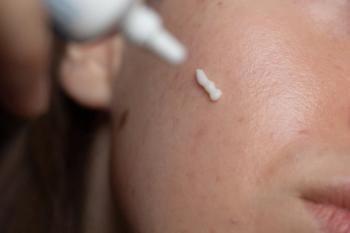
Botulinum Toxin A and Hyaluronic Acid Reduce Acne-Caused Enlarged Pores, New Study Finds
Key Takeaways
- Combining botulinum toxin A and hyaluronic acid significantly improves acne-related enlarged pores, with notable results at 1 and 4 months post-treatment.
- The study involved 40 patients, showing high satisfaction rates and significant improvements in pore size, texture, and porphyrins.
A study reveals that combining botulinum toxin A and hyaluronic acid significantly reduces acne-related enlarged pores, enhancing skin texture and patient satisfaction.
Using botulinum toxin A combined with non-cross-linked hyaluronic acid can improve enlarged pores caused by acne, according to a new study.1 Improvements were seen 1 and 4 months after treatment, with approximately 90% of patients being satisfied with pores, texture, and porphyrins.
The retrospective study included 40 patients, who were recruited from the outpatient department of the First Affiliated Hospital of Xi'an Jiaotong University's dermatology department. Eight males and 32 females between the ages of 18 and 40 were diagnosed with acne and thus, large pores. Most were classified as Fitzpatrick skin type IV.
At administration, each participant received 30 to 50 units of botulinum toxin A, which controls sebum and shrinks pores, and 2.5 mL of hyaluronic acid, which hydrates the dermis and maintains water retention. The compound was injected using mesotherapy with 9 32-gauge microneedles.
Full-face imageswere taken using the VISIA Skin Image Analyzer at baseline, 1 month after treatment, and 4 months after treatment. These photos were used to evaluate facial pores, texture, and porphyrins. Lower scores indicated smoother skin with a decrease in pore size and sebum secretion.Physicians used the Global Aesthetic Improvement Scale (GAIS) as well as a 5-level patient satisfaction score.
Significant improvement in pore size value was noted 1 month after treatment, dropping from 22.3 to 16.7 (p < 0.01). The texture value improved from 7.8 to 5.7 while the porphyrin value changed from 10.8 to 6.3 (p < 0.01), indicating lowered sebum secretion. After 4 months, the effects did decrease slightly, but pores (17.8), texture (6.1), and porphyrins (7.1) were still better than baseline levels. Nonetheless, these results were much better than using botulinum toxin A on its own.
After 1 month, the overall treatment effectiveness was at a rate of 95%, according to the GAIS evaluation. Texture and porphyrin improvement was 92.5% and 95%, respectively. At the 4-month follow-up, these rates were reduced slightly to 87.5%, 85%, and 82.5%, respectively. Most patients observed “improved” or “much improved” pores, texture, and porphyrins. Only 2 patients had no changes in pores and no participants had a worsening of symptoms. At the 4-month mark, 4 patients did request another round of treatment after their enlarged pores returned.
In terms of satisfaction rates, nearly 90% of patients were satisfied 1 month after the treatment session. This decreased by 10% after 4 months. The therapy was relatively well tolerated, with only a few cases of erythema, bruising, and tightness. All patients described a mildly painful sensation during injection, but this was relieved immediately after treatment. There were no severe adverse reactions, including asymmetry in the face or brow, muscle weakness, allergic reactions, respiratory distress, or fatigue.
Current treatments for enlarged pores work to inhibit the secretion of sebaceous glands. Therapies such as isotretinoin, topical retinoic acid, and chemical peeling involve long-term treatment and may cause adverse effects.2 The combination therapy of botulinum toxin A and hyaluronic acid fillers is commonly used for wrinkles and volume loss but using it for enlarged pores is rarely reported.
“This finding suggests that combination therapy has a significant advantage in the duration of effectiveness retention,” the authors concluded. “We have reason to believe that BTX-A and HA complement each other, and their combination is more effective than a single application.”
References
1. Yang R, Bai Y, Liu C, et al. Combination of Botulinum Toxin A and Hyaluronic Acid Improved Facial Pore Enlargement Caused by Acne. J Cosmet Dermatol. 2025;24(4):e70198. doi:10.1111/jocd.70198
2. Haroun M. Hormonal therapy of acne. J Cutan Med Surg. 2004;8 Suppl 4:6-10. doi:10.1007/s10227-004-0753-9
Newsletter
Like what you’re reading? Subscribe to Dermatology Times for weekly updates on therapies, innovations, and real-world practice tips.


















